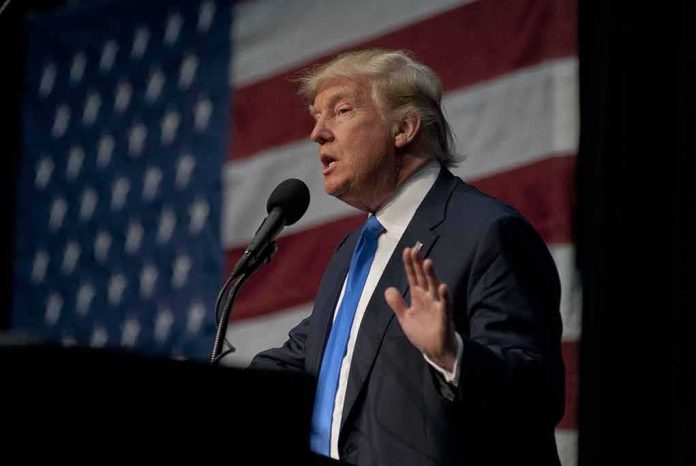
When a president confesses his own economic weapon is “not sustainable” yet refuses to back down, the world stops to ask: is this strategy, stubbornness, or a calculated dare against global markets?
Story Snapshot
- Trump publicly admits his 157% tariff on Chinese imports is “not sustainable”—but will not change course.
- The move marks the highest tariff in modern U.S.-China trade history, sparking market turmoil.
- Businesses, consumers, and global supply chains reel as a 100% tariff increase looms for November 1, 2025.
- Analysts warn of economic pain, but Trump frames the measure as political leverage against Beijing.
Trump’s Tariff Gambit: A New High-Wire Act in U.S.-China Trade
Donald Trump stood before cameras in October 2025 and did something few politicians ever do: he admitted a core policy is “not sustainable.” The 157% tariff on Chinese imports, he said, will inflict too much pain if left unchecked. Yet, with a characteristic shrug, Trump signaled he would not retreat or revise his approach. The world’s largest economies now face a standoff where the architect of the tariffs acknowledges the wreckage ahead and still presses forward, turning economic orthodoxy and political playbooks on their heads.
This is not Trump’s first foray into weaponizing tariffs. Trade tensions with China exploded during his first term, with tit-for-tat levies and market volatility becoming routine. The Biden administration offered a temporary reprieve, dialing back some tariffs and opening negotiations. But Trump’s return to the White House in 2025 marked a sharp escalation. By June, the administration had adjusted steel and aluminum tariffs and threatened even broader sanctions. By July, Trump floated the possibility of further increases—and by November 1, a new 100% hike would take effect, casting a long shadow over holiday shopping and export-dependent businesses.
Unprecedented Scale and Open Contradictions
The 157% tariff is not just another number—it’s an economic earthquake. Previous trade wars saw dramatic but smaller measures; this tariff dwarfs them all. Trump’s admission of its unsustainability is a rare moment of candor in American trade politics. Historically, leaders defend such moves as necessary, even in the face of economic fallout. Trump, however, frames the tariff as a high-stakes bargaining chip, openly acknowledging that its pain is meant to force China’s hand. Critics call this brinkmanship; supporters see it as the only language Beijing understands. Either way, the contradiction is clear: Trump’s strategy is to inflict maximum pressure while publicly conceding its dangers.
China’s response has been swift and severe. Chinese officials condemned the tariffs, threatening reciprocal measures targeting U.S. agricultural and energy exports. Legal challenges are already underway in U.S. courts, with affected industries and trade groups lining up to contest the scale and scope of the new levies. Meanwhile, the U.S. Trade Representative continues to enforce the administration’s policy, while the Chinese Ministry of Commerce counters with export controls on critical minerals. The result is a trade relationship defined by suspicion, retaliation, and profound uncertainty.
Winners, Losers, and the Ripple Effect on Main Street
For American businesses that rely on Chinese components—especially in technology, automotive, and consumer electronics—the costs are immediate and painful. Higher prices ripple through supply chains, squeezing margins and forcing difficult choices. U.S. consumers will see the impact on store shelves, from smartphones to sneakers. Farmers and energy producers, once hopeful for new markets, now face Chinese retaliation that threatens livelihoods already battered by years of global instability.
Markets respond with volatility as investors scramble to predict the next move. The broader economic effects are equally dramatic: inflationary pressures, job losses in affected sectors, and the specter of a long-term decoupling between the U.S. and China. For some, this is an overdue reckoning with Beijing’s trade practices. For others, it’s economic self-harm, driven more by politics than pragmatism. The legal system may yet intervene, with the U.S. District Court for the District of Columbia set to rule on key challenges. But for now, the tariffs stand, holding the global economy hostage to a high-stakes game of chicken.
Expert Perspectives: Calculated Pressure or Political Grandstanding?
Trade experts and economists across the spectrum warn that tariffs of this magnitude rarely achieve their intended goals. Instead, they disrupt supply chains, raise consumer prices, and often backfire diplomatically. Academic studies of past trade conflicts—from Smoot-Hawley in the 1930s to the 2018-2019 U.S.-China trade war—show that punitive measures rarely deliver lasting wins. Yet Trump’s team argues that only overwhelming force can counter China’s state subsidies, forced technology transfers, and intellectual property abuses. The debate divides along familiar lines: national security and industrial policy versus free-market economics and global cooperation.
As November approaches and the 100% tariff increase looms, the world waits to see whether Trump’s hardline stance will yield concessions or deepen the rift. Businesses brace for impact, legal challenges mount, and both supporters and critics agree on one thing: this is uncharted territory for American trade policy. The only certainty is uncertainty itself—a condition that Trump, for all his candor, seems willing to risk in pursuit of leverage. Whether that gamble pays off, or leads to long-term damage, remains the open question haunting global markets and Main Street alike.












